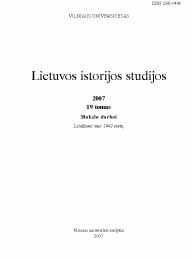VISUOMENES NUOMONES VEIKIMO SALYGOS SOVIETINEJE LIETUVOJE
THE CONDITIONS OF PUBLIC OPINION ACTION IN SOVIET LITHUANIA
Author(s): Valdemaras KlumbysSubject(s): History
Published by: Vilniaus Universiteto Leidykla
Summary/Abstract: This article discusses conditions and environment in which public opinion operated in Soviet Lithuania. Such environment influenced public opinion nature and its lineaments. Public opinion differed markedly from mass opinion, though it was tied up with it. One of the main Soviet society differences from Western one was that functions of Western public sphere were divided between several social spheres. Two of them are discussed in present article: national and common spheres. Common sphere encompass that part of public that is physically open to everyone; in this sphere thing or action can be seen by everyone who wants. So, very little part of social sphere goes with the territory of common sphere as distinct from Western public sphere. Common sphere was almost totally controlled by Soviet regime and that was another important difference from Western public sphere. Soviet parallel of latter might have been the intermediate sphere, in which existed independent from regime institutions and relationships that organized social life at a level between the state and the family. All the social networks and institutions were informal and acted in the realm of private life. But this sphere wasn’t a part of private sphere because of it significance and operation mode. Common sphere wasn’t part of intermediate sphere as distinct from national sphere. Latter was main sphere where intellectuals created public opinion. Only this social group had position that gave it an opportunity to generate and protect public opinion that was widely accepted by masses and known and sometimes considered by administrative elite. Cultural elite was involved into common and national spheres simultaneously. Discourses, had been essential to all people, could survive and function only in common sphere and only such discourses can be named as public ones. Cultural elite smuggled parts of anti-soviet and other officially not permitted discourses from national to common spheres in hidden forms (as subtext). That enabled integrity of national discourses, national sphere and existence of independent public opinion. Cultural elite was the main producer of public opinion, as it was in XVIII c., when classical public opinion emerged. But cultural elite totally depended economically and socially from regime. Double mind was necessary to interlink absolutely different discourses (official and national, as they were opposite sometimes). This means, that there were differences not only in practice (“real feelings” of an intellectual) and mythology (official ideology, expressed in common sphere – mass media, official meetings etc.) of public opinion. There were two mythologies of public opinion. One was expressed in common sphere – it was designed for regime. Another was a façade to heighten social status among national sphere’s participants (other intellectuals) and were ethnically centered, anti-soviet. Practice differed from both mythologies and was designed for material welfare mostly
Journal: Lietuvos istorijos studijos
- Issue Year: 2007
- Issue No: 19
- Page Range: 124-138
- Page Count: 15
- Language: Lithuanian

